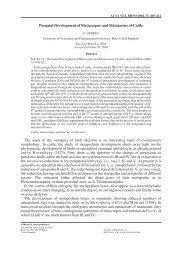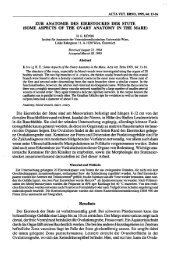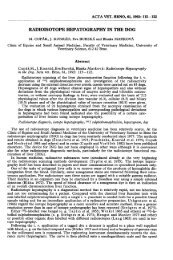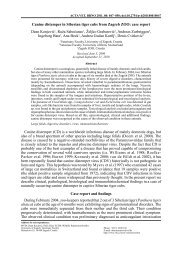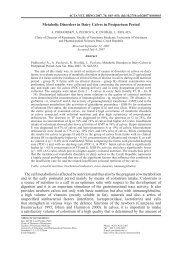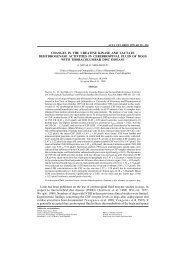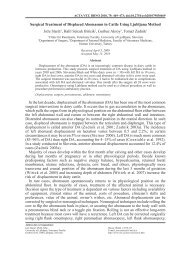Activity of Enzymes and Trace Element Content in Bee Honey ...
Activity of Enzymes and Trace Element Content in Bee Honey ...
Activity of Enzymes and Trace Element Content in Bee Honey ...
Create successful ePaper yourself
Turn your PDF publications into a flip-book with our unique Google optimized e-Paper software.
ACTA VET. BRNO 2002, 71: 375–378<br />
<strong>Activity</strong> <strong>of</strong> <strong>Enzymes</strong> <strong>and</strong> <strong>Trace</strong> <strong>Element</strong> <strong>Content</strong> <strong>in</strong> <strong>Bee</strong> <strong>Honey</strong><br />
L. VORLOVÁ, O. âELECHOVSKÁ<br />
Department <strong>of</strong> Biochemistry <strong>and</strong> Biophysics, Faculty <strong>of</strong> Veter<strong>in</strong>ary Hygiene <strong>and</strong> Ecology,<br />
University <strong>of</strong> Veter<strong>in</strong>ary <strong>and</strong> Pharmaceutical Sciences, Brno, Czech Republic<br />
Received March 11, 2002<br />
Accepted June 19, 2002<br />
Abstract<br />
Vorlová L., O. âelechovská: <strong>Activity</strong> <strong>of</strong> <strong>Enzymes</strong> <strong>and</strong> <strong>Trace</strong> <strong>Element</strong> <strong>Content</strong> <strong>in</strong> <strong>Bee</strong> <strong>Honey</strong>.<br />
Acta Vet. Brno 2002, 71: 375-378.<br />
The objective <strong>of</strong> this study was to assess the relation between the activity <strong>of</strong> enzymes (<strong>in</strong>vertase<br />
<strong>and</strong> diastase) <strong>and</strong> the contents <strong>of</strong> trace essential elements (Fe, Mn, Zn <strong>and</strong> Cu) <strong>and</strong> risk elements<br />
(Pb, Cd <strong>and</strong> Hg). A collection <strong>of</strong> thirty honey samples from various regions <strong>of</strong> the Czech Republic<br />
was arranged <strong>in</strong>to three groups by the botanical orig<strong>in</strong> <strong>of</strong> honeys (blossom-rape, blossommultifloral<br />
<strong>and</strong> honeydew), <strong>and</strong> analysed. The differences <strong>in</strong> copper content reached high<br />
significance (P < 0.01) between honeydew(1.5± 0.4 mg · kg -1 ) <strong>and</strong> blossom-multifloral (0.7± 0.5<br />
mg· kg -1 ) or blossom-rape honey (0.3 ± 0.2 mg kg -1 ) samples, <strong>and</strong> (P< 0.05) between blossommultifloral<br />
<strong>and</strong> blossom-rape honey samples. A significant correlation was found between the<br />
activity values <strong>of</strong> <strong>in</strong>vertase <strong>and</strong> diastase (r = 0.8072, P < 0.01), <strong>and</strong> between the enzyme activity<br />
<strong>and</strong> the copper content (<strong>in</strong>vertase/Cu r = 0.5192, P < 0.05; diastase/Cu r = 0.4868, P < 0.05). No<br />
significant correlation was found between the enzyme activity <strong>and</strong> the content <strong>of</strong><br />
hydroxymethylfurfural (HMF). <strong>Honey</strong>dew conta<strong>in</strong>ed higher concentrations <strong>of</strong> essential <strong>and</strong> risk<br />
elements <strong>and</strong> simultaneously showed higher enzyme activity than honey blossom.<br />
Invertase, diastase, essential metals, risk elements<br />
<strong>Enzymes</strong> are the most important <strong>and</strong> also the most <strong>in</strong>terest<strong>in</strong>g honey components. They<br />
are accountable for the conversion <strong>of</strong> nectar <strong>and</strong> honeydew to honey, <strong>and</strong> serve as a<br />
sensitive <strong>in</strong>dicator <strong>of</strong> the honey treatment. In some countries, the specification <strong>of</strong> enzymes<br />
is a b<strong>in</strong>d<strong>in</strong>g legal <strong>in</strong>dicator (Bogdanov et al. 1987; Codex Alimentarius 1993; Oddo<br />
et al. 1999). Even though the enzyme role was not found <strong>in</strong> human diet, the activity <strong>of</strong><br />
enzymes participates <strong>in</strong> the biological value <strong>of</strong> honey. The contents <strong>of</strong> essential trace<br />
elements also participate <strong>in</strong> the nutritional value <strong>of</strong> honey <strong>and</strong> it is one <strong>of</strong> the factors<br />
affect<strong>in</strong>g the colour <strong>of</strong> honey. Literature presents a whole spectrum <strong>of</strong> physicochemical<br />
properties <strong>of</strong> honeys from separate geographical regions, though mostly without any closer<br />
specification <strong>of</strong> their botanical orig<strong>in</strong>s (Yilmaz <strong>and</strong> Yavuz 1999; Caroli et al. 1999;<br />
Kump et al. 1996).<br />
The objective <strong>of</strong> this study was to determ<strong>in</strong>e the enzyme activity <strong>of</strong> α-glucosidase<br />
(<strong>in</strong>vertase) <strong>and</strong> α- <strong>and</strong> ß-amylase (diastase), the contents <strong>of</strong> hydroxymethylfurfural (HMF =<br />
5-hydroxymethylfuran-2-carbaldehyde) <strong>and</strong> the contents <strong>of</strong> essential <strong>and</strong> risk trace elements<br />
for three groups <strong>of</strong> honey samples sorted by their botanical orig<strong>in</strong>s; <strong>and</strong> then, to assess the<br />
differences between these groups <strong>and</strong> to f<strong>in</strong>d out the <strong>in</strong>fluence <strong>of</strong> the particular analytes on<br />
the activity <strong>of</strong> enzymes by statistical methods.<br />
Materials <strong>and</strong> Methods<br />
A collection <strong>of</strong> thirty honey samples was analysed. All samples were obta<strong>in</strong>ed directly from beekeepers <strong>in</strong><br />
various regions <strong>of</strong> the Czech Republic dur<strong>in</strong>g the year 2000. The honey samples were sorted by their botanical<br />
orig<strong>in</strong> <strong>in</strong>to three groups: blossom-multifloral (n = 10), blossom-rape (n = 10), <strong>and</strong> honeydew (n = 10). In each<br />
sample, we determ<strong>in</strong>ed the enzyme activity <strong>of</strong> <strong>in</strong>vertase <strong>and</strong> diastase <strong>and</strong> the content <strong>of</strong> essential (Cu, Fe, Mn <strong>and</strong><br />
Address for correspondence:<br />
Ing. O. âelechovská, Ph.D.<br />
Department <strong>of</strong> Biochemistry <strong>and</strong> Biophysics<br />
University <strong>of</strong> Veter<strong>in</strong>ary <strong>and</strong> Pharmaceutical Sciences<br />
Palackého 1-3, 612 42 Brno, Czech Republic<br />
Phone: +420 5 4156 2506<br />
E-mail: Celechovskao@vfu.cz<br />
http://www.vfu.cz/acta-vet/actavet.htm
376<br />
Zn) <strong>and</strong> contam<strong>in</strong>ant (Cd, Pb, Hg) trace elements. Before be<strong>in</strong>g analysed, all honey samples were kept <strong>in</strong> glass<br />
vessels at room temperature, <strong>and</strong> protected from light. The enzyme activity <strong>and</strong> the content <strong>of</strong> HMF were<br />
determ<strong>in</strong>ed with<strong>in</strong> a month after honey extraction.<br />
Analytical methods used for the <strong>in</strong>dividual analytes:<br />
The activity <strong>of</strong> enzymes<br />
Invertase (α-glucosidase, EC 3.2.1.20) – measured by the method by Siegenthaler with spectrophotometric<br />
evaluation (UV/VIS spectrometer Lambda 11, Perk<strong>in</strong> Elmer, USA). The results are given <strong>in</strong> units <strong>of</strong> activity per<br />
1 kg <strong>of</strong> honey (U/kg), alternatively as an <strong>in</strong>vertase number (IN) (Bogdanov et al. 1997).<br />
Diastase (α- <strong>and</strong> ß-amylase, EC 3.2.1.1, EC 3.2.1.2) – by the Shade method. The results are given as a diastase<br />
number (DN) (Bogdanov et al. 1997).<br />
HMF (5-hydroxymethylfuran-2-carbaldehyde alternatively 5-hydroxymethylfurfural) – measured by the<br />
W<strong>in</strong>kler method (Bogdanov et al. 1997).<br />
Cu, Fe, Mn, Zn - measured us<strong>in</strong>g a flame technique AAS (atomic absorption spectrometry, model Z-5000,<br />
Perk<strong>in</strong>-Elmer, USA) after the dissolution <strong>of</strong> the sample ash <strong>in</strong> 0.2 mol/l HCl (ash – by burn<strong>in</strong>g <strong>in</strong> a muffle furnace<br />
LM 312.11, MLW Germany; Bogdanov et al. 1997).<br />
Pb, Cd – by an electrothermal technique AAS after the preced<strong>in</strong>g m<strong>in</strong>eralization by nitric acid <strong>in</strong> a microwave<br />
autoclave Uniclever (Plasmatronica, Pol<strong>and</strong>). The atomic absorption spectrometer (model Z-5000) was set to the<br />
conditions recommended by the manufacturer (Perk<strong>in</strong>-Elmer, USA). The used AAS method showed the follow<strong>in</strong>g<br />
detection limits (def<strong>in</strong>ed as the concentration equivalent to 3 times the st<strong>and</strong>ard deviation <strong>of</strong> the analytical blank<br />
signal, n = 10: Cd = 0.25 µg·kg -1 , Pb = 4.5 µg·kg -1 ).<br />
Hg - the measurement was done on a mercury analyzer AMA 254 (Altec Ltd., the Czech Republic). Detection<br />
limit 0.01 ng Hg.<br />
The precision <strong>and</strong> accuracy <strong>of</strong> the AAS methods was verified us<strong>in</strong>g the recovery test that ranged from 94.2% to<br />
105.1%. The result<strong>in</strong>g data were processed by statistical package Unistat ® , version 5.1. The mean values <strong>of</strong> analyte<br />
concentrations <strong>and</strong> st<strong>and</strong>ard deviations were calculated for each separate group <strong>of</strong> honey samples <strong>and</strong> submitted to<br />
the correlation analysis <strong>and</strong> Student´ s t-test.<br />
Results <strong>and</strong> Discussion<br />
Fig. 1 shows the content <strong>of</strong> the HMF <strong>and</strong> the essential elements for each separate group<br />
<strong>of</strong> honey samples. The content <strong>of</strong> the HMF was very low for all three groups (blossommultifloral:<br />
3.04 ± 1.93; blossom-rape: 1.74 ± 1.57; honeydew: 5.83 ± 5.62<br />
mg⋅kg -1<br />
12<br />
9<br />
6<br />
3<br />
0<br />
Blossom-Rape<br />
Blossom-Multifloral<br />
<strong>Honey</strong>dew<br />
HMF Zn Fe Mn Cu<br />
Fig. 1. The content <strong>of</strong> the HMF <strong>and</strong> essential elements <strong>in</strong> honeys grouped<br />
by botanical orig<strong>in</strong> (mean ± SD)<br />
mg·kg -1 ). The content <strong>of</strong> the<br />
essential trace elements (Fe,<br />
Mn, Zn, <strong>and</strong> Cu) varied for each<br />
group; however, only the Cu<br />
content showed significant<br />
differences (Tab. 1). The<br />
concentrations <strong>of</strong> metals <strong>in</strong><br />
honeydew honeys found by us<br />
are <strong>in</strong> agreement with those<br />
found by Yilmaz <strong>and</strong> Yavuz<br />
(1999) <strong>and</strong> Rodriguez-<br />
Otero et al. (1994). Except for<br />
the z<strong>in</strong>c concentration that<br />
Kump et al. (1996) reported to<br />
be higher, the concentrations <strong>of</strong><br />
the other elements were<br />
consistent, too. The concentrations <strong>of</strong> metals <strong>in</strong> blossom-multifloral <strong>and</strong> blossom-rape<br />
honey samples were lower than the concentrations <strong>in</strong> honeydew samples. To our<br />
knowledge, there are no studies that would analyze systematically honeys grouped by their<br />
botanical orig<strong>in</strong>. Therefore comparison with literature references is difficult. Literature<br />
data report only the contents <strong>of</strong> the <strong>in</strong>dividual metals without sort<strong>in</strong>g the honey samples by<br />
their botanical orig<strong>in</strong>.<br />
The concentrations <strong>of</strong> potentially toxic elements (Pb, Cd, Hg – Table 2) were very low<br />
(median Pb: 0.053 mg·kg -1 ; Cd: 3.3 µg·kg -1 ; Hg: 1.2 µg·kg -1 ). Statistically significant
377<br />
<strong>Honey</strong> Blossom-Rape <strong>Honey</strong>dew<br />
Blossom-<br />
Multifloral<br />
Table 1<br />
Statistically significant differences <strong>in</strong> the content <strong>of</strong> the particular components between three groups<br />
<strong>of</strong> honey samples sorted by botanical orig<strong>in</strong> (* P < 0.05, ** P < 0.01)<br />
Blossom-Rape<br />
differences (P < 0.05) were found <strong>in</strong> the content <strong>of</strong> Cd <strong>and</strong> Hg between honeydew <strong>and</strong> blossommultifloral<br />
honey samples, <strong>and</strong> between blossom-rape <strong>and</strong> honeydew samples (Table 1),<br />
which factually comports with our earlier work (âelechovská <strong>and</strong> Vorlová 2001).<br />
<strong>Honey</strong><br />
Fig. 2 shows the diastase <strong>and</strong> <strong>in</strong>vertase activity values for three separate groups <strong>of</strong> honey<br />
samples. Both enzymes showed statistically significant differences (P < 0.05) between<br />
blossom-multifloral <strong>and</strong> honeydew honey<br />
samples (Table 1). The enzyme activity values<br />
found by us were higher than those published<br />
by Golob <strong>and</strong> Plestenjak (1999) <strong>and</strong><br />
Yilmaz <strong>and</strong> Yavuz (1999) <strong>and</strong> lower than<br />
values published by Oddo et al. (1999); the<br />
honey samples exam<strong>in</strong>ed <strong>in</strong> the abovementioned<br />
studies were from different<br />
regions. After perform<strong>in</strong>g correlation analysis<br />
between the activity values <strong>of</strong> enzymes <strong>and</strong> the<br />
content <strong>of</strong> essential <strong>and</strong> risk elements, we<br />
found some significant correlative<br />
dependences (P < 0.05) between the diastase<br />
Cu * Cu ** , Fe * , Zn * , Hg * ,<br />
Cd * , Diastase,<br />
Invertase<br />
– Cu ** , Mn ** , Zn ** ,<br />
Hg * , Cd *<br />
Table 2<br />
<strong>Content</strong> <strong>of</strong> risk elements <strong>in</strong> honey samples (mean ± SD)<br />
Pb Cd Hg<br />
(mg·kg -1 ) (µg·kg -1 )<br />
Blossom-Rape 0.096 ± 0.056 1.55 ± 0.58 1.05 ± 0.17<br />
Blossom-Multifloral 0.042 ± 0.033 1.85 ± 1.75 1.08 ± 0.36<br />
<strong>Honey</strong>dew 0.095 ± 0.040 19.3 ± 13.9 1.91 ± 0.58<br />
activity value <strong>and</strong> the Cu content (r = 0.49), <strong>and</strong> between the <strong>in</strong>vertase activity value <strong>and</strong> the<br />
Cu content (r = 0.52).<br />
The highly significant correlation (P < 0.01, r = 0.81) between diastase <strong>and</strong> <strong>in</strong>vertase<br />
activity values is also <strong>in</strong> agreement with the study by Oddo et al. (1999). However, we<br />
found no significant correlation between the enzyme activity <strong>and</strong> the HMF content.<br />
Enzymová aktivita a stopové prvky ve vãelím medu<br />
Pfiedmûtem studie jsou vztahy mezi aktivitou enzymÛ (<strong>in</strong>vertasy a diastasy) a obsahem<br />
stopov˘ch esenciálních (Fe, Mn, Zn, Cu) a rizikov˘ch (Pb, Cd a Hg) prvkÛ. Vzorky medÛ<br />
byly získány od vãelafiÛ z rÛzn˘ch oblastí âeské republiky v roce 2000. Bylo analyzováno<br />
30 vzorkÛ medÛ rozdûlen˘ch do skup<strong>in</strong> podle pÛvodu (kvûtové-fiepkové, kvûtové-smí‰ené<br />
40<br />
30<br />
20<br />
10<br />
0<br />
Diastase (DN)<br />
Invertase (IN)<br />
Blossom-Rape Blossom-Multifloral <strong>Honey</strong>dew<br />
Fig. 2. <strong>Activity</strong> <strong>of</strong> enzymes for each honey group (mean ± SD)
378<br />
a medovicové). Skup<strong>in</strong>a medovicov˘ch medÛ se statisticky v˘znamnû li‰ila v obsahu<br />
esenciálních i rizikov˘ch prvkÛ od ostatních skup<strong>in</strong>. Mûì vykazovala statisticky vysoce<br />
v˘znamn˘ rozdíl (P < 0,01) mezi medovicov˘mi 1,5 ± 0,4 mg.kg -1 a kvûtov˘mi-smí‰en˘mi<br />
0,7 ± 0,5 mg.kg -1 nebo kvûtov˘mi-fiepkov˘mi 0,3 ± 0,2 mg.kg -1 medy, statisticky v˘znamn˘<br />
rozdíl (P < 0,05) mezi kvûtov˘mi-smí‰en˘mi a kvûtov˘mi-fiepkov˘mi medy. Byly nalezeny<br />
signifikantní korelace mezi aktivitou <strong>in</strong>vertasy a diastasy (r = 0,8072, P < 0,01), a mezi<br />
enzymovou aktivitou a obsahem Cu (<strong>in</strong>vertasa/Cu r = 0,5192, P < 0,05; diastasa/Cu r =<br />
0,4868, P < 0,05). Nebyla nalezena statisticky v˘znamná korelace mezi enzymovou<br />
aktivitou a obsahem HMF (5-hydroxymethylfurfural). Medovicov˘ med obsahoval vy‰‰í<br />
koncentrace esenciálních a rizikov˘ch prvkÛ a souãasnû vykazoval vy‰‰í enzymovou<br />
aktivitu neÏ med kvûtov˘.<br />
Acknowledgements<br />
The research support was provided by the M<strong>in</strong>istry <strong>of</strong> Education, Youth <strong>and</strong> Sports <strong>of</strong> the Czech Republic, grant<br />
No 162700005.<br />
References<br />
BOGDANOV, S, MARTIN, P, LÜLLMANN, C 1997: Harmonised Method <strong>of</strong> the European <strong>Honey</strong> Commission.<br />
Apidologie (extra issue), p. 59<br />
BOGDANOV, S, RIEDER, K, RÜEGG, M 1987: Neue Qualitätskriterien bei Honiguntersuchungen. Apidologie<br />
18: 267–278<br />
CAROLI, S, FORTE, G, IAMICELI, AL, GALOPPI, B 1999: Determ<strong>in</strong>ation <strong>of</strong> essential <strong>and</strong> potentially toxic trace<br />
elements <strong>in</strong> honey by ICP techniques. Talanta 50: 327-336<br />
CODEX ALIMENTARIUS STANDARD FOR HONEY, 1993: Ref. Nr. CL 1993/14-SH FAO <strong>and</strong> WHO, Rome,<br />
27 p.<br />
âELECHOVSKÁ, O, VORLOVÁ, L 2001: Groups <strong>of</strong> honey – physicochemical properties <strong>and</strong> heavy metals. Acta<br />
Vet Brno 70: 91-95<br />
GOLOB, T, PLESTENJAK, A 1999: Quality <strong>of</strong> Slovene honey. Food technol Biotechnol 37: 195-201<br />
KUMP, P, NEâEMER, M, NAJDER, J 1996: Determ<strong>in</strong>ation <strong>of</strong> trace elements <strong>in</strong> bee honey, pollen <strong>and</strong> tissue by<br />
total reflection <strong>and</strong> radioisotope X-ray fluorescence spectrometry. Spectrochim Acta Part B 51: 499-507<br />
ODDO, LP, PIAZZA, MG, PULCINI, P 1999: Invertase activity <strong>in</strong> honey. Apidologie 30: 57-65<br />
RODRIGUEZ-OTERO, JL, PASEIRO, P, SIMAL, J, CEPEDA, A 1994: M<strong>in</strong>eral content <strong>of</strong> the honeys produced<br />
<strong>in</strong> Galicia. Food Chem 49: 169-171<br />
YILMAZ, H. YAVUZ, O 1999: <strong>Content</strong> <strong>of</strong> some trace metals <strong>in</strong> honey from south-eastern Anatolia. Food Chem<br />
65: 475-476



